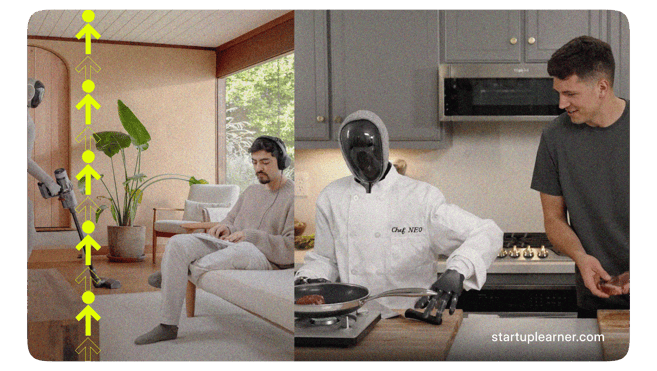Humanoid Robots and the Future of Humanity: How NEO is Changing Everything
AINEW
Startup Learner
4/13/20253 min read



How Humanoid Robots Like NEO Could Redefine Humanity's Future
In the span of just two centuries, humans have transformed energy from a scarce, unimaginable luxury into an invisible, abundant resource. Today, energy powers every part of our daily lives with the flip of a switch. It’s no longer a marvel—it’s simply expected.
Now, a similar shift is on the horizon, not with energy, but with labor itself.
The rise of humanoid robots, like NEO developed by 1X Technologies, signals the beginning of a future where labor could become as abundant, accessible, and invisible as electricity.
The Dream: Labor as a Readily Available Resource
Today, robots are often confined to manufacturing lines, handling repetitive, isolated tasks. But Bernt Børnich, founder of 1X Technologies, envisions something much greater: a world where robots not only perform chores but help solve humanity's biggest challenges.
Imagine a world where robots do laundry, assist the elderly, build infrastructure, and even conduct scientific experiments—all with minimal human intervention.
The promise of abundant labor isn't just about convenience; it’s about giving humans back something even more valuable: time.
With this regained time, people could focus more on creativity, innovation, relationships, and exploring the deeper questions of existence.
Why Home, Not Factory, Is the Key to Intelligence
Traditionally, robots have been trained in industrial settings—performing the same narrow task over and over. This approach was logical, but flawed.
Børnich’s team discovered that real intelligence doesn’t emerge from repetition.
It comes from diversity and unpredictability—the very conditions that homes, not factories, provide.
In a home, a simple object like a cup isn’t just a cup. It can be clean, dirty, in use, misplaced, or even part of a complex social context.
Training robots in this chaotic, human-centered environment forces them to develop nuanced understanding and adaptive reasoning—the foundations of real intelligence.
This insight mirrors how large language models evolved: they grew smarter not by studying narrow domains, but by consuming the messy diversity of the entire internet.
Living and Learning Among Us
Starting in 2023, 1X Technologies placed humanoid robots like Eve and NEO in homes.
These robots perform tasks with a mix of autonomous behavior and remote expert guidance. As they live and interact in human spaces, their capabilities grow, moving steadily toward full autonomy.
The more environments they experience, the more varied the tasks they perform, the faster they learn—just like humans.
This daily immersion in real-world environments, not just controlled labs or factories, will be key to unlocking their full potential.
The Breakthrough: Safe, Soft, and Adaptable Robots
One of the biggest hurdles in humanoid robotics has always been safety. Traditional robots are rigid, powerful, and dangerous.
NEO is different. Inspired by human muscles, NEO uses soft tendons instead of stiff mechanical joints.
This makes NEO:
Quiet
Lightweight
Safe around people
Flexible enough to adapt to unpredictable human environments
NEO doesn’t just perform tasks; it moves through the world in a way that feels natural, almost companion-like.
The future relationship between humans and robots won't be mechanical—it will be social.
More Than Chores: Solving Humanity’s Grand Challenges
While it’s easy to dream about robots helping with daily chores, Børnich’s vision extends much further:
Robots could build data centers and chip fabrication plants, accelerating the growth of AI itself.
Robots could construct massive scientific infrastructure like particle accelerators.
Robots could operate labs worldwide, conducting experiments at unprecedented scales.
Through this symbiosis between humans and machines, we could unleash a new era of scientific discovery—one that tackles the deepest mysteries of the universe.
Redefining What It Means to Be Human
At its core, this revolution isn't just about robots.
It’s about giving humanity the freedom to move beyond basic survival tasks.
It's about rediscovering what it means to be human when we’re no longer weighed down by the limits of physical labor.
When energy became abundant, it changed civilization forever.
When labor becomes abundant, the change could be even greater.
Humanoid robots like NEO aren't just technological marvels.
They represent a profound opportunity: to build a future where every human being can focus on creation, exploration, and meaning.
And that future is closer than we think.



